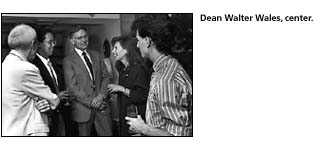Dean's Column
Arts & Sciences-A Common Responsibility
Last fall, as I worked to prepare a summary of the strategic plan for building the School of Arts and Sciences in the future, I looked for a few easily-captured highlights to set the tone of the summary. I found outstanding scholarly accomplishments by many individual faculty members and impressive national rankings of entire departments. The hard evidence of our distinction was based on the collective scholarship of departments and graduate groups and their prowess in providing training to graduate students. I looked, with much less success, for similar evidence to use in describing our undergraduate programs. Part of the problem was that undergraduate programs do not lend themselves to puffery - nor do they change in dramatic ways from year to year. Real improvements are a constant process, made over the course of time, and tend to be evolutionary rather than revolutionary. Reasonable quantitative goals, for next year or for the next five years, are not easily isolated or set.
As I sorted through these issues I found it useful to think more about what the School of Arts and Sciences actually was and what it did. The School is an organic whole for which faculty, students, and staff are all essential. Faculty, with the help of staff, pursue their own scholarship and mentor and teach both graduate students and undergraduate students. The exact mix of scholarship, mentoring, and teaching not only varies a great deal from faculty member to faculty member but it also varies from time to time for any individual faculty member. All of these functions are important to the School. We would be impoverished if any one were absent.
Next came the realization that this same collection of statements can be
made with equal precision about each of the other schools that enroll
undergraduate students. There is nothing in the paragraph above that
distinguishes the School of Arts and Sciences from the School of
Engineering, the School of Nursing, or the Wharton School. Clearly, what
I needed was to find some way in which the School of Arts and Sciences is
intrinsically different from these other schools. I concluded that the
defining principle for these other schools was the professional
orientation of their faculties. Although undergraduate education is very
important to all of them, each school could, at least in principle,
exist if its faculty were committed only to its own scholarship and
research and to the training of graduate and professional students.

In the School of Arts and Sciences, on the other hand, there is no
common profession - except perhaps "college professor" - that unites the
faculty. The scholarship of my colleagues in the Department of Physics
and Astronomy has remarkably little in common with that done by faculty
members in the Department of English. Our graduate students and theirs
may share the same campus and live in similar off-campus apartments, but
they experience quite different training and have quite different
professional aspirations. If either department were to disappear
tomorrow (no inferences please!) the scholarship and the graduate
program of the other would be unaffected.
At the undergraduate level, however, it is just this remarkable range of faculty backgrounds and interests that allows the School of Arts and Sciences to provide a broad liberal education to its students. The faculty members not only provide instruction in their own disciplines, but work collectively to insure that the overall undergraduate program both provides a foundation of knowledge and promotes the development of essential creative and critical skills in the students who will be tomorrow's leaders. It is the faculty's shared commitment to excellence in undergraduate education, and only that commitment, that defines the School of Arts and Sciences.
The "glue" of this School is its faculty's vision of the value of a liberal arts education for our undergraduates and their common responsibility to provide that education. It is the undergraduate students who unite faculty from departments across the School. The College of Arts and Sciences is not only one very important answer to the "what is" question about the School of Arts and Sciences, but it is the only answer to the "why is" question. Without the College we would be an eclectic set of departments, sharing a campus and talking together about "scholarship" while meaning very different things. In the last analysis, the College is the reason that the School exists.